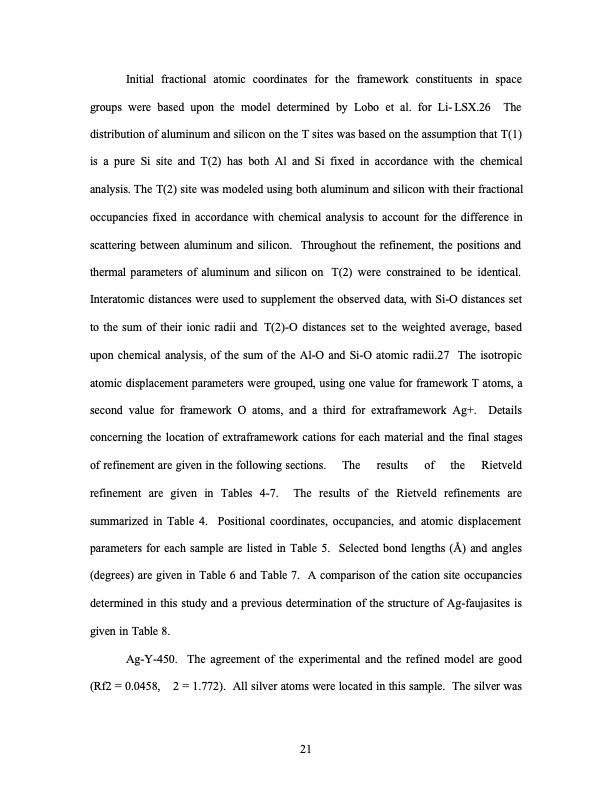
PDF Publication Title:
Text from PDF Page: 021
Initial fractional atomic coordinates for the framework constituents in space groups were based upon the model determined by Lobo et al. for Li-LSX.26 The distribution of aluminum and silicon on the T sites was based on the assumption that T(1) is a pure Si site and T(2) has both Al and Si fixed in accordance with the chemical analysis. The T(2) site was modeled using both aluminum and silicon with their fractional occupancies fixed in accordance with chemical analysis to account for the difference in scattering between aluminum and silicon. Throughout the refinement, the positions and thermal parameters of aluminum and silicon on T(2) were constrained to be identical. Interatomic distances were used to supplement the observed data, with Si-O distances set to the sum of their ionic radii and T(2)-O distances set to the weighted average, based upon chemical analysis, of the sum of the Al-O and Si-O atomic radii.27 The isotropic atomic displacement parameters were grouped, using one value for framework T atoms, a second value for framework O atoms, and a third for extraframework Ag+. Details concerning the location of extraframework cations for each material and the final stages of refinement are given in the following sections. The results of the Rietveld refinement are given in Tables 4-7. The results of the Rietveld refinements are summarized in Table 4. Positional coordinates, occupancies, and atomic displacement parameters for each sample are listed in Table 5. Selected bond lengths (Å) and angles (degrees) are given in Table 6 and Table 7. A comparison of the cation site occupancies determined in this study and a previous determination of the structure of Ag-faujasites is given in Table 8. Ag-Y-450. The agreement of the experimental and the refined model are good (Rf2 = 0.0458, 2 = 1.772). All silver atoms were located in this sample. The silver was 21PDF Image | PSA USING SUPERIOR ADSORBENTS

PDF Search Title:
PSA USING SUPERIOR ADSORBENTSOriginal File Name Searched:
789503.pdfDIY PDF Search: Google It | Yahoo | Bing
CO2 Organic Rankine Cycle Experimenter Platform The supercritical CO2 phase change system is both a heat pump and organic rankine cycle which can be used for those purposes and as a supercritical extractor for advanced subcritical and supercritical extraction technology. Uses include producing nanoparticles, precious metal CO2 extraction, lithium battery recycling, and other applications... More Info
Heat Pumps CO2 ORC Heat Pump System Platform More Info
| CONTACT TEL: 608-238-6001 Email: greg@infinityturbine.com | RSS | AMP |